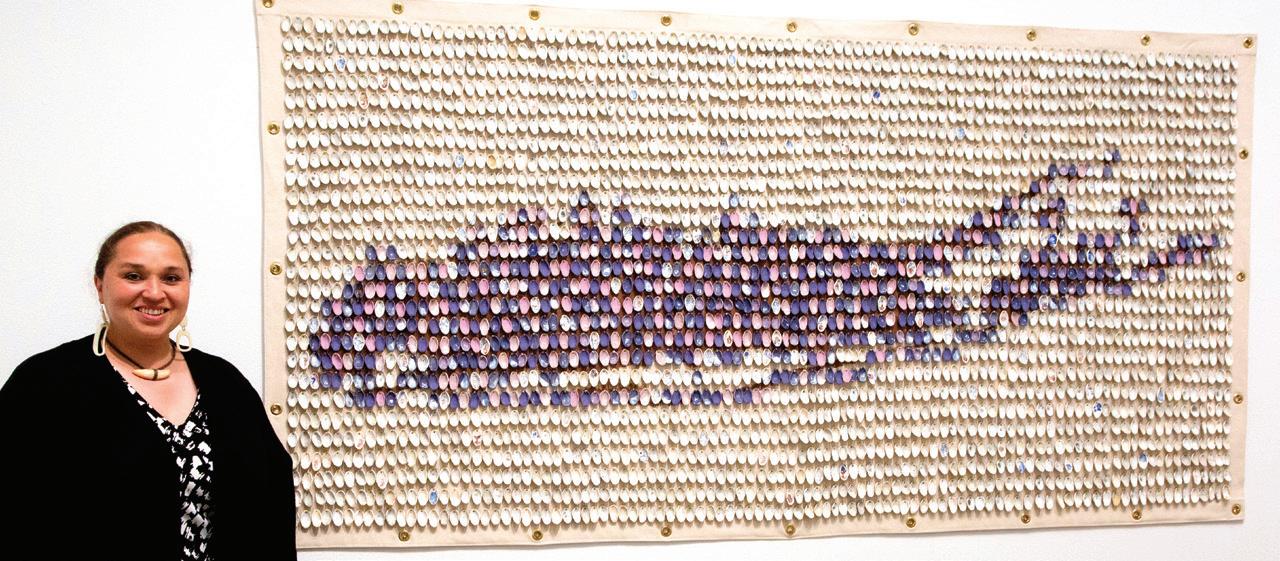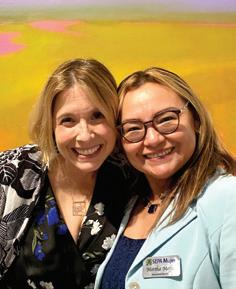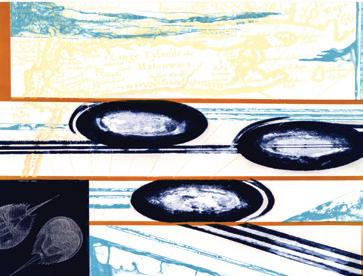
4 minute read
FROM THE EXECUTIVE DIRECTOR
Dear Friends,
As geese and swans carefully assembled nests in Heckscher Park, Art in Bloom enthralled visitors with abundant creativity from neighborhood garden clubs. The 27th Annual Long Island’s Best filled our galleries with extraordinary works created by some of the region’s most talented high school students as spring continued to offer multiple opportunities for all of us to come together as a community to explore the concept of Home.
Our year-long exploration of Home now continues this summer, with the opening of our newest exhibition, COURTNEY M. LEONARD: LOGBOOK 2004-2023. The exhibition features paintings, ceramics, and multi-media work which engages with Long Island’s history, amplifies Indigenous cultural knowledge, expresses reverence for the earth and sea, while advocating for their protection.
Through the presentation of thoughtful and exquisite artwork, combined with opportunities for reflection and discussion, the Museum hopes to be a home for dynamic commu- nity conversations. Our new Dinner with the Director series has featured intimate conversations with Huntington African American History Museum Chair Barry Lites, Executive Director of SEPA Mujer Martha Maffei (pictured), Shinnecock Nation Environmental Department Director Shavonne Smith, artists Jeremy Dennis and Brianna Hernandez, and the culinary delights of Gingerbites Haitian Bistro, Afghan Kitchen 44, and food sustainability programs from the Shinnecock Reservation and the ELIJA Farm. If you have yet to enjoy one of these intimate gatherings in our galleries, we so hope you will join us for one of the remaining dinners of the year.
We are proud to have also launched a new Heckscher@Home art lending program, a collaboration with the Town of Huntington Department of Cultural Affairs, to help bring fine art into the homes of our veterans.
Friends, as the year progresses, we will continue to strive to find new ways to open our home – the Museum – to the community, in new and meaningful ways, as a space for exploration, inspiration, and conversation. Please be in touch with your ideas as to how we can further this work.
With admiration and gratitude, Heather Arnet

The Heckscher Museum Of Art Board Of Trustees
Executive Committee
Robin T. Hadley Chair
Margaret M. Hargraves
Vice Chair
Trudy H. Calabrese
Vice Chair
Bruce A. Lev, CPA Treasurer
Robert J. Aquilina Secretary
Pien Bosch
Jessica Brassler
Colette Buzzetta
John T. Callaghan, CPA, CFE
John E. Coraor, Ph.D.
Richard T. Cunniff, Jr.
Priscilla C. Hughes, Esq.
Bette Schneiderman, Ph.D.
Bruce Segal
Greg Wagner Liaison from the Town of Huntington
Art In Bloom
The Museum was proud to partner with four local garden clubs to present this crowd-pleasing, multisensory experience: Asharoken Garden Club (top), Dix Hills Garden Club (above), North Suffolk Garden Club (Stony Brook), and South Side Garden Club (Bay Shore). On view April 14-16, teams from each club created floral designs inspired by works of art in the exhibitions Viewfinders: Photographers Frame Nature and Raise the Roof: The Home in Art. The designers rose to the occasion to produce twelve beautiful and creative arrangements that wowed visitors.
See photos of all Art in Bloom designs at Heckscher.org/events/art-in-bloom


Sponsored by Robin T. Hadley
Thank You to our 2023 Designers
Jane Arbeiter, Nancy Binger, Christina Campolettano, Marilyn Carroll, Patricia Jo Casella, Kathryn de Winter-Hart, Joan Enright, Kathleen Fernandez, Carolyn Fricke, JoAn Gaudreault, Michelle Gaughran, Nan Gibbons, Denise Gibson, Kathy Jokubiel, Marilyn LaPenta, Marilyn Light, Tina Mattimore, Diane Matsui, Deanna Muro, Michelle Pittman, Kathy Posillico, Joan Rockwell-Gifford, Martha Stansbury, and Maureen Wawrzonek.
Exhibitions
Through November 12
Sponsors
LOGBOOK 2004-2023 is the first exhibition to explore two decades of Courtney M. Leonard’s artwork. Through her work in ceramics, painting, and installation art, Leonard expresses an enduring commitment to ecological concerns and Indigenous cultural viability. It highlights rarely exhibited early sculptures and debuts CONTACT 2,023…, composed of thousands of shell-like ceramic thumbprints. Commissioned by The Heckscher Museum for its permanent collection, this “map” interprets the encounters between Long Island’s Indigenous people and European colonizers. The immersive installation in the final gallery extends Leonard’s ongoing project BREACH Modeled on logbooks kept by whaling ships, BREACH: Logbook 23 | ALLUVION records Leonard’s experiences of “environmental fragility, shifting adaptations, and/or the ability to simply become anew.”
The Heckscher Museum presents this exhibition in conjunction with Planting Fields Foundation’s new site-specific installation, BREACH: Logbook 23 | ROOT, by Courtney M. Leonard. Visit plantingfields.org for more information.

In Her Own Words
Two artworks in the exhibition are CONTACT 2,023…, commissioned by The Heckscher Museum for its permanent collection, and Blue Blood (2015) which Leonard created for the U.S. Art In Embassies program. Learn more about these works in Leonard’s own words.
“CONTACT 2,023… interprets the early encounters between the Indigenous People of the Long Island area and the Europeans, by creating a work that acknowledges that colonists did not arrive at empty shores. Indigenous communities were standing along these shores, possibly viewing the tall ships as they sailed along Long Island’s coastlines, the women wearing dresses adorned with wampum shells sewn across in rows. In response to the notion of ‘contact,’ this work sets to reestablish a visual recognition of the continued presence of these Indigenous communities through the physical action of ‘contact’ as well as a recording of this physical presence in time. The colors of the work are inspired by the purple tones of our wampum combined with the blue and white history of Dutch delftware. Each ceramic thumbprint, glazed individually and sewn to map Long Island, New York, continues the cultural iconography of the times.”


“Blue Blood is a response and visual account of current issues of environmental fragility and cultural sustainability pertaining to climate change and economic viability. The composition is a reflection of nautical flags and charting, and the physical paper is etched with the image of an antique map of Long Island.
As a child, I grew up walking the shoreline to witness the early summer season spawning and shell shedding of the horseshoe crabs. This memory is visually striking as both a marker of one of the oldest creatures on earth and, as I grew older and saw fewer along the shores, of their potential decline and extinction. It has been well published in the past few decades: the use of their blood, the color of which is blue, within the pharmaceutical industry as an antigen. Previous to this economic use, horseshoe crabs have been used by baymen outside of the Shinnecock community in the fertilizer industry and as bait for the growing eel market overseas.
Learn More From The Artist
COURTNEY M. LEONARD, co-published with Planting Fields Foundation, debuts in July.
Museum Publication Sponsors
Jessica Brassler and George Kakoulides
Cathy Raphael



